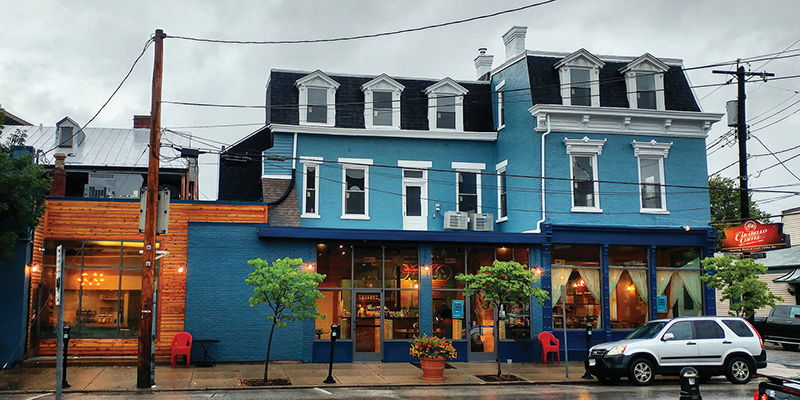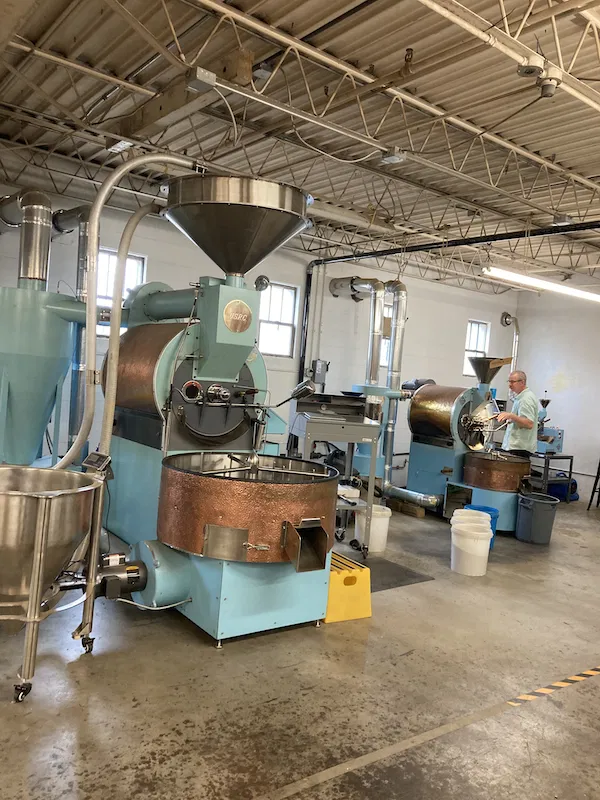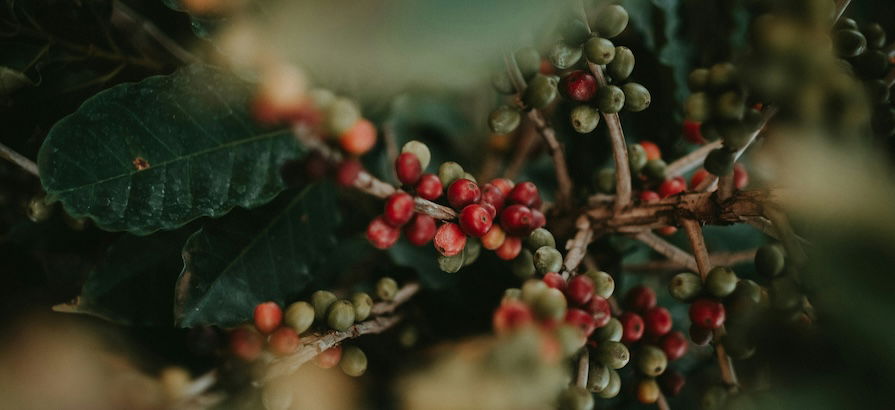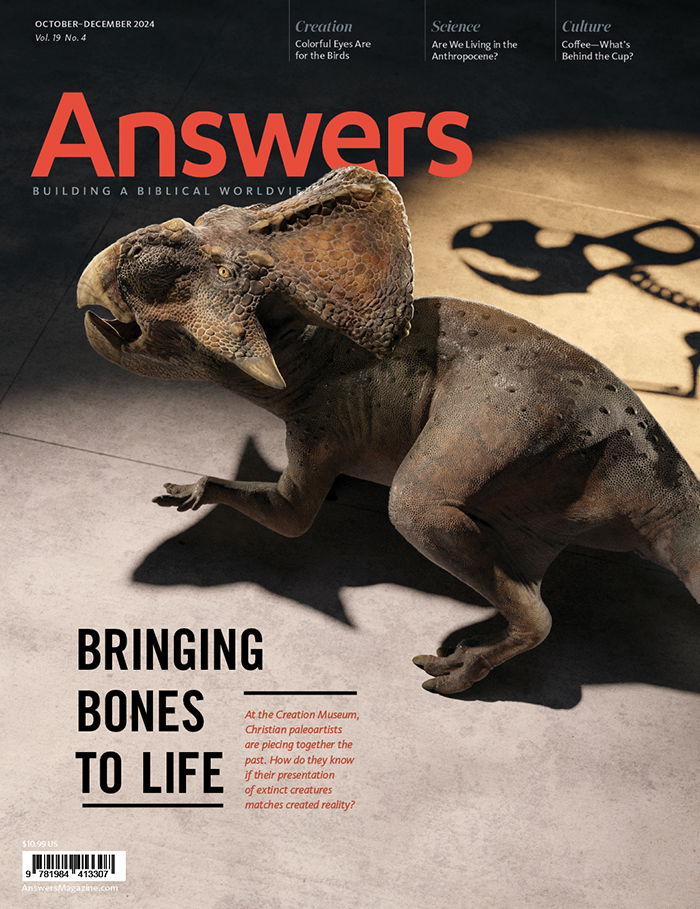What's in a Cup?
Down the road and around the world, coffee connects a community of people.
On most weekends, you’ll find me seated at the Analog Coffee Bar, an experience at Carabello Coffee shop in Northern Kentucky. Analog offers specialty drinks on a themed, six-week rotating menu. Guests reserve a seat at the glossy wooden countertop to watch a barista craft drinks and to savor the unique flavors. Analog Through Art was a recent menu theme. And each drink was as much a masterpiece as the famous work of art that inspired it.
Menu
Double Elvis by Andy Warhol
Peanut butter and honey cappuccino with dehydrated banana chips as garnish.
Jolly Cones by Wayne Thiebaud
This affogato features candy, vanilla gelato, and a cone hat that you can deconstruct by pouring espresso over it.
Coffee Harvest by Candido Portinari
A refreshing cascara tea (coffee cherries), simple syrup, Topo Chico, and lemon juice.

The iconic blue exterior and unique beverages make Carabello Coffee a popular spot in Newport, KY.
With each new menu, I wonder at the creativity in each concoction. Flavors that shouldn’t pair well with coffee somehow work, leaving my taste buds happy and my brain buzzing with caffeine.
Customers at Analog are far from the only ones who enjoy a cup of coffee. The world consumes over 2.25 billion cups each day. Coffee is considered America’s favorite beverage, and the numbers reflect that. The US spent $8.2 billion on coffee imports in 2023—twice as much as any other nation.1 The average US coffee drinker consumes three cups per day. Many people feel that they wouldn’t make it without their morning caffeine, me included. But in spite of spending so much time sipping bean juice, we rarely consider the complex journey the beans take to get into our beverage.
From the beginning, God commanded mankind to steward creation by cultivating it—and that includes coffee (Genesis 1:28–30). When it comes to coffee, a whole network of people cultivate the beans from farm to cup.
What’s in My Cup?
Because today’s consumers desire quality ingredients and are concerned about human rights issues, they want to know where their products come from. Additionally, coffee aficionados often look for connection and an experience served with their cup of joe. As a result, philanthropic, or relationship, coffee has become increasingly popular in our culture.
Few people take relationship coffee more seriously than Justin and Emily Carabello, the owners of Carabello Coffee and the visionaries behind Analog Coffee Bar. The Carabellos opened their coffee shop with relationships in mind—relationships with their customers, baristas, roasters, and coffee producers. Each year, the Carabellos visit coffee farms in Costa Rica, Honduras, and Nicaragua. That means they source their coffee directly from farmers they know by name, and they can trace the source of every bean they brew.
I had no idea that a coffee bean is actually a fruit pit.
Until a few months ago, despite my daily coffee consumption, I had no idea that a coffee bean is actually a fruit pit. I learned this from Emily Carabello as she showed me around the Carabello roasting facility. Turns out, that was just a drop in the cup of what I didn’t know about coffee.
The Root of Coffee
The coffee plant kind was created by God on the third day of creation week about 6,000 years ago. Arabica coffee (the most common species of coffee and probably the bean you brewed this morning) comes from the Coffea arabica plant, indigenous to Ethiopia. This small tree produces coffee cherries. Inside each cherry is a pit, called the “bean.”
Coffee plants are mainly grown on farms in what’s called the Bean Belt, a stretch of land around the planet on either side of the equator. Countries along the Bean Belt, such as Brazil, Vietnam, Colombia, Indonesia, and Ethiopia, tend to have more tropical, temperate climates and a rainy season—the ideal environment for growing coffee.2
Many countries that sit along or near the Bean Belt are also located in the Ring of Fire, an area with active volcanoes and frequent earthquakes, stretching nearly 25,000 miles (40,000 km) around the edges of the Pacific Ocean. The Ring of Fire was formed by the global flood about 4,500 years ago. When “the fountains of the great deep broke forth” (Genesis 7:11), earth’s original crust broke up into continents that shifted, creating ridges and trenches and opening volcanoes. Volcanic activity produces the fertile, mineral-rich soil in which coffee grows best.
Today, coffee is still affected by a climate continuing to settle from the flood events. As weather patterns change, coffee-abundant countries are no longer experiencing a predictable rainy season and dry season like they used to, making growing certain varieties of coffee more challenging. The Carabellos’ coffee farmers have experienced this firsthand.
“There are parts of the countries that used to be really good for coffee that are suddenly not good for coffee,” Justin said. “And then there are parts of the countries that never were good for coffee that are suddenly becoming good for coffee.”
Emily explained further, “Since coffee is a little flowering plant, it can get knocked off in a massive storm. Then it’s not going to create a cherry. So these kinds of things are happening because of weird rain patterns where flowers and fully ripe cherries are on the same plant at the same time when they’re supposed to be a month apart.”
Some scientists are concerned that climate change will soon cause coffee to disappear completely.3 But these challenges are prompting farmers to innovate and researchers to look for solutions.
“Even since we started,” Emily said, “we’ve really been amazed at the nations themselves creating science-based coffee. They are starting to pour money into it. We need that research.”
A pair of studies published in 2024 took a closer look at the genetic sequencing of Arabica coffee. The results could lead to genetic modification and breeding to produce stronger varieties that better withstand climate fluctuations and other threats, including disease.4
Coffee is especially at risk for disease because coffee crops are predominantly monocultural, an agricultural practice that involves growing only one crop in a field or area. Monoculture is efficient but can be dangerous. “It’s kind of like the potato famine in Ireland,” Emily explained. “If a disease were to come, coffee would be all gone.”
Growing coffee plants and developing new varieties might be the most obvious example of cultivating creation. But once the plants are grown, the process passes on to the pickers.
Pick of the Crop
On the mountainous terrain where coffee often grows, picking with machinery is nearly impossible. In most places, coffee cherries are handpicked according to ripeness and sorted by variety, or species.
After the fruit is picked, the pit (coffee bean) must be removed through one of several methods. The three most common include a washed process (the cherry is removed from the pit by being washed with water), a dry or natural process (the cherry is left in the sun to dry and then is removed), and what’s called a honey process, which combines the wet and dry processes.
After being processed, the coffee beans get sent to a mill where they are sorted by size, weight, shape, and quality. This seemingly simple task of uniformly sorting a batch of beans has a significant impact on the coffee’s flavor.
“Imagine you’ve got a little cookie and a big cookie in the oven at the same time,” Emily said. “They’ll bake differently. It’s the same with the roaster. You want same-size beans so they all roast evenly.”
From the mills, raw coffee beans are shipped to roasters, often on the other side of the world.
Behind the Beans
At the Carabello’s roastery, a pile of burlap sacks sits in the corner. On my tour, Emily scooped a handful of light green coffee beans from a sack and held them out to me. I inhaled their earthy scent, surprised by the contrast between these raw beans and the dark, richly scented ones I brew each morning. Across the room, two large blue metal roasters stood waiting to transform the beans into their familiar appearance.

All Carabello coffee is roasted by two machines and one roastmaster.
The raw beans arrive at the roaster with a small amount of moisture still trapped inside. The first stage of roasting involves loading the beans into a rotating metal drum to be heated. As the beans dry, the roastmaster increases the heat in the drum, causing the sugars and amino acids in the beans to caramelize, developing their color, aroma, and flavor compounds.
The temperature and roast time determine whether the batch will be a light, medium, or dark roast. A roastmaster must consider bean size, moisture content, and quality to determine how long to roast the beans.
Once the beans reach the desired roast, they are immediately cooled to stop the roasting process. Then they are packaged and shipped to supermarkets, consumers, or coffee shops, ready for the delicious next step—crafting the beans into a beverage.
Supporting Farmers

Coffee farmers around the world cultivate the beans that become the brew in your cup. Yet many are underpaid for their hard work. What can you do to support coffee farmers?
- Buy fair trade coffee. Fair trade promotes sustainable farming practices and ensures farmers are being paid fair wages.
- Buy direct trade coffee. Some coffee brands (like the Carabellos’) establish direct relationships with coffee growers.
- Educate yourself on where your coffee is coming from and the challenges facing coffee farmers.
- Reduce waste. Only brew what you need.
- Build relationships with your local coffee shops that support sustainable, fair trade coffee.
Community Built on a Bean
Cortado, cappuccino, iced, skinny, decaf, extra foam, four pumps of syrup, oat milk, whole milk, sprinkle of nutmeg, drizzle of caramel—with so many ways for baristas to create beverages, no wonder making coffee is called a craft.
Baristas and coffee shop owners are cultivating something else: a place for people to gather.
Skilled baristas do more than pour coffee, though. They consider factors like where the coffee was grown and under which conditions, how long it was roasted, how finely it is ground, and the flavor profiles in the beans. A good barista knows the correct temperature for brewing different roasts, the water quality for the best tasting coffee, how to tamp down coffee grounds into an evenly dispersed espresso puck, and even how to service the café equipment.
But beyond pulling the perfect shot of espresso, pouring intricate latte art, or making flavored syrups, baristas and coffee shop owners are cultivating something else: a place for people to gather.
Historically, coffee has been the beverage over which people have socialized, shared ideas, and started revolutions. In the seventeenth century, sultans of the Ottoman empire banned coffeehouses after they became gathering places for political dissidents. In seventeenth-century London, coffeehouses became known for cheap coffee and big ideas, earning them the nickname “penny universities.” In eighteenth-century Boston, Massachusetts, the Green Dragon coffeehouse and tavern—known as the “Headquarters of the Revolution”—was a meeting spot for the Sons of Liberty, including Paul Revere.
Time of the Bean
- 1453 The Ottomans introduce coffee to Constantinople (modern Istanbul).
- 1475 World’s first coffeehouse, Kiva Han, opens in Constantinople.
- 1607 It is believed that Captain John Smith brought coffee to North America.
- 1616 The Dutch smuggle a coffee plant out of an Arab port.
- 1652 London’s first coffeehouse opens.
- 1720 Italy’s first coffeehouse opens.
- 1840 Brazil becomes the largest coffee exporter in the world and remains so today, growing nearly one-third of the world’s coffee.
- 1852 First French press design is patented.
- 1865 First coffee percolator is patented.
- 1884 Espresso machine is invented and patented.
- 1900 Hills Bros. begin packaging roasted coffee in sealed tins for people to brew at home.
- 1908 Paper coffee filter is patented by German woman, Melitta Bentz.
- 1929 Design for modern French press is patented.
- 1954 First electric drip coffee maker is invented.
- 1972 Electric drip coffee maker is popularized across America by Mr. Coffee brand.
Today, you can hardly drive through a city without passing a café on nearly every street. And just as in the past, coffee shops still make space for creativity, connection, and thought revolutions. In fact, coffee shops are considered the “third place,” a location other than home or the office, a place where you can be known and build relationships. With this in mind, most coffee shop owners pump out free Wi-Fi, offer charging stations, and boast ample seating, creating a sort of community living room. Enter any coffee shop, and you might walk in on a business meeting, job interview, study session, first date, or meetup of friends.
The Carabellos’ vision for Analog Coffee Bar presses even deeper into fostering relationships. When I walk in on a Saturday morning, the barista behind the bar greets me with, “Welcome, friend!” After my first couple of visits, they knew me by name. While sipping photo-worthy drinks, I learn about the coffee in my cup—and sometimes, even something new about the barista behind the counter and the friends sitting around me.
Justin hopes Analog will continue to be a place where people can find both a good cup of coffee and a community. “We want to be a place where people love coming, that they just want to keep coming back because they’re treated with dignity, they’re known, they’re valued, and they get something really interesting and engaging.”
Spaces like this provide a place for our part in the cultivation process—building relationships.
Pouring into Others
Though you might not tend the coffee plants, pick the cherries, roast the beans, own a café, or craft the beverages, you’re still called to steward coffee well.
“The Lord gives us good things,” Emily said. “Apples are good, but if no one picks them and no one delivers them and no one juices them and no one sells them, then we are inhibited from ever experiencing the good thing God gave us. You are a part of the Lord’s plan to get good things to people.”
Coffee is a good thing. But we must be careful not to sip without savoring, to consume as a way to cope. We bring God glory by intentionally enjoying this delightful little bean he has made. But we’re also called to nurture relationships and make disciples. Encouragement, friendship, the gospel—it’s up to us to get these good things to others. And what better way than to invite someone to enjoy a cup of coffee with you?
The Carabellos and other coffee roasters like them are fulfilling God’s call to tend the earth and bring forth food—and drink—for us to enjoy (Psalm 104:14–15). And as they do so, they’ve built a community that passes the beans from hand to hand—both down the street and around the world.
The Impact of Terroir

If you’ve ever wondered why specialty coffees all taste so different, the answer lies largely in something called terroir. Terroir refers to the unique combination of factors such as climate, soil, and geography that influence the characteristics of the coffee plant and play a crucial role in defining the coffee’s flavor profile.
Altitude
Coffees grown at high-altitude tend to highlight more complex flavors (like fruits and florals) and acidity due to the oxygen levels, cooler temperatures, and slower bean maturation. Low-altitude coffees often hold a more flat, mellow, and soft flavor profile, with notes of nuts and dried fruits.
Weather
Consistency in weather patterns can lead to stable and predictable coffee characteristics. Meanwhile, unpredictable weather can lead to wild and sometimes wacky flavor variations like watermelon, peach, sugar cookie, cedar, cherry, grape, or passion fruit. This unpredictability draws enthusiasts seeking the next unexpected cup of coffee.
Soil
Farmers particularly favor mineral-rich volcanic soil to cultivate coffee. Regions like Costa Rica and even Hawaii, with their largely volcanic landscapes, produce coffee cherries with unique and complex flavors.
Micro Lots
Small plots, sometimes even as small as two acres, are meticulously managed to yield unique and exceptional beans. They also allow farmers to experiment with different processing methods and harvest times without affecting a whole farm.
Answers Magazine
October–December 2024
At the Creation Museum, Christian paleoartists are piecing together the past. How do they know if their presentation of extinct creatures matches created reality?
Browse IssueFootnotes
- Statista, “Leading Coffee Importing Countries Worldwide in 2023,” Statista, June 19, 2024, https://www.statista.com/statistics/1096400/main-import-countries-for-coffee-worldwide/.
- Anshool Deshmukh, “The World’s Top Coffee Producing Countries,” Visual Capitalist, October 1, 2021, https://www.visualcapitalist.com/worlds-top-coffee-producing-countries/.
- Climates do change, but these changes are not necessarily caused by humans. God designed earth with cyclic, climatic processes. For more information about a biblical view of climate change, read Jessica DeFord’s article, “Climate Crisis or Media Hype? Investigating the Reality of Earth’s Climate,” answersingenesis.org/environmental-science/climate-change/investigating-reality-of-earths-climate/.
- Nick Brown, “Breeding and Genetics Study Traces Arabica to Prehistoric Times,” Daily Coffee News by Roast Magazine, July 3, 2024, https://dailycoffeenews.com/2024/07/03/breeding-and-genetics-study-traces-arabica-to-prehistoric-times/. Univerity of Buffalo, “Newly Sequenced Genome Reveals Coffee’s Prehistoric Origin Story, and Its Future Under Climate Change,” Phys.org, April 15, 2024, https://phys.org/news/2024-04-newly-sequenced-genome-reveals-coffee.html#google_vignette. And Simone Scalabrin et al., “A Chromosome-Scale Assembly Reveals Chromosomal Aberrations and Exchanges Generating Genetic Diversity in Coffea arabica Germplasm,” Nature Communications 15, no. 463 (2024): https://www.nature.com/articles/s41467-023-44449-8.
Recommended Resources

Answers in Genesis is an apologetics ministry, dedicated to helping Christians defend their faith and proclaim the good news of Jesus Christ.
- Customer Service 800.778.3390
- Available Monday–Friday | 9 AM–5 PM ET
- © 2026 Answers in Genesis







